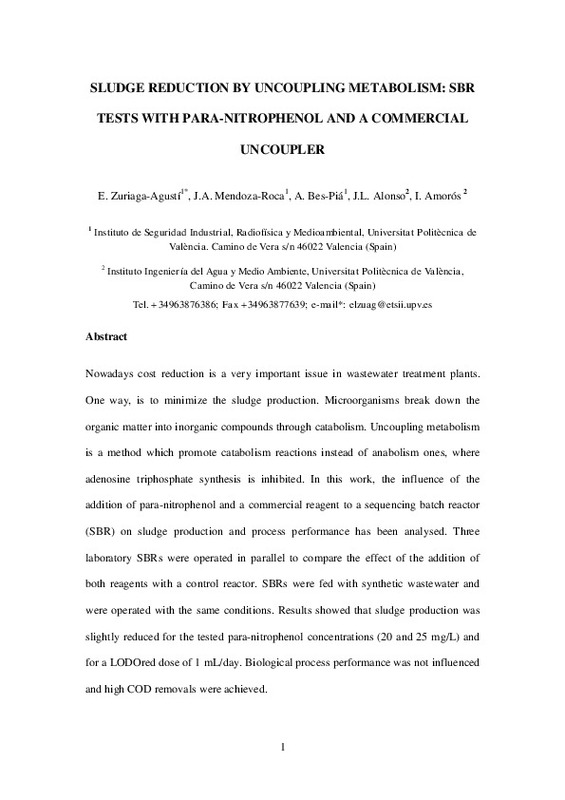JavaScript is disabled for your browser. Some features of this site may not work without it.
Buscar en RiuNet
Listar
Mi cuenta
Estadísticas
Ayuda RiuNet
Admin. UPV
Sludge reduction by uncoupling metabolism: SBR tests with para-nitrophenol and a commercial uncoupler
Mostrar el registro sencillo del ítem
Ficheros en el ítem
| dc.contributor.author | Zuriaga Agustí, Elena
|
es_ES |
| dc.contributor.author | Mendoza Roca, José Antonio
|
es_ES |
| dc.contributor.author | Bes Piá, Mª Amparo
|
es_ES |
| dc.contributor.author | Alonso Molina, José Luís
|
es_ES |
| dc.contributor.author | Amoros Muñoz, Inmaculada
|
es_ES |
| dc.date.accessioned | 2017-05-04T07:49:44Z | |
| dc.date.available | 2017-05-04T07:49:44Z | |
| dc.date.issued | 2016-11-01 | |
| dc.identifier.issn | 0301-4797 | |
| dc.identifier.uri | http://hdl.handle.net/10251/80551 | |
| dc.description.abstract | Nowadays cost reduction is a very important issue in wastewater treatment plants. One way, is to minimize the sludge production. Microorganisms break down the organic matter into inorganic compounds through catabolism. Uncoupling metabolism is a method which promote catabolism reactions instead of anabolism ones, where adenosine triphosphate synthesis is inhibited. In this work, the influence of the addition of para-nitrophenol and a commercial reagent to a sequencing batch reactor (SBR) on sludge production and process performance has been analyzed. Three laboratory SBRs were operated in parallel to compare the effect of the addition of both reagents with a control reactor. SBRs were fed with synthetic wastewater and were operated with the same conditions. Results showed that sludge production was slightly reduced for the tested para-nitrophenol concentrations (20 and 25 mg/L) and for a LODOred dose of 1 mL/day. Biological process performance was not influenced and high COD removals were achieved. (C) 2016 Elsevier Ltd. All rights reserved. | es_ES |
| dc.description.sponsorship | This work was supported by Universitat Politecnica de Valencia (Project reference: PAID-05-12). | en_EN |
| dc.language | Inglés | es_ES |
| dc.publisher | Elsevier | es_ES |
| dc.relation.ispartof | Journal of Environmental Management | es_ES |
| dc.rights | Reserva de todos los derechos | es_ES |
| dc.subject | Wastewater treatment | es_ES |
| dc.subject | Cell disruption | es_ES |
| dc.subject | Viability | es_ES |
| dc.subject | Sludge reduction | es_ES |
| dc.subject | Metabolic uncoupler | es_ES |
| dc.subject.classification | INGENIERIA QUIMICA | es_ES |
| dc.title | Sludge reduction by uncoupling metabolism: SBR tests with para-nitrophenol and a commercial uncoupler | es_ES |
| dc.type | Artículo | es_ES |
| dc.identifier.doi | 10.1016/j.jenvman.2016.07.100 | |
| dc.relation.projectID | info:eu-repo/grantAgreement/UPV//PAID-05-12/ | es_ES |
| dc.rights.accessRights | Abierto | es_ES |
| dc.contributor.affiliation | Universitat Politècnica de València. Escuela Técnica Superior de Ingenieros Industriales - Escola Tècnica Superior d'Enginyers Industrials | es_ES |
| dc.contributor.affiliation | Universitat Politècnica de València. Instituto Universitario de Ingeniería del Agua y del Medio Ambiente - Institut Universitari d'Enginyeria de l'Aigua i Medi Ambient | es_ES |
| dc.contributor.affiliation | Universitat Politècnica de València. Instituto de Seguridad Industrial, Radiofísica y Medioambiental - Institut de Seguretat Industrial, Radiofísica i Mediambiental | es_ES |
| dc.description.bibliographicCitation | Zuriaga Agustí, E.; Mendoza Roca, JA.; Bes Piá, MA.; Alonso Molina, JL.; Amoros Muñoz, I. (2016). Sludge reduction by uncoupling metabolism: SBR tests with para-nitrophenol and a commercial uncoupler. Journal of Environmental Management. 182:406-411. https://doi.org/10.1016/j.jenvman.2016.07.100 | es_ES |
| dc.description.accrualMethod | S | es_ES |
| dc.relation.publisherversion | http://dx.doi. org/10.1016/j.jenvman.2016.07.100 | es_ES |
| dc.description.upvformatpinicio | 406 | es_ES |
| dc.description.upvformatpfin | 411 | es_ES |
| dc.type.version | info:eu-repo/semantics/publishedVersion | es_ES |
| dc.description.volume | 182 | es_ES |
| dc.relation.senia | 330477 | es_ES |
| dc.identifier.eissn | 1095-8630 | |
| dc.contributor.funder | Universitat Politècnica de València | es_ES |






![[Cerrado]](/themes/UPV/images/candado.png)


